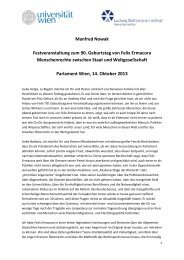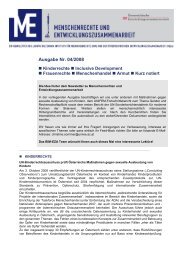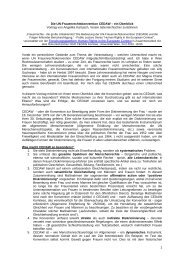International perspectives on positive action measures - European ...
International perspectives on positive action measures - European ...
International perspectives on positive action measures - European ...
Create successful ePaper yourself
Turn your PDF publications into a flip-book with our unique Google optimized e-Paper software.
<str<strong>on</strong>g>Internati<strong>on</strong>al</str<strong>on</strong>g> <str<strong>on</strong>g>perspectives</str<strong>on</strong>g> <strong>on</strong> <strong>positive</strong> acti<strong>on</strong> <strong>measures</strong><br />
or <strong>positive</strong> acti<strong>on</strong>. An educator stated<br />
that, previously, African Americans<br />
had been excluded from schools and<br />
higher educati<strong>on</strong>.<br />
Leadership also emerged in Canada<br />
as a key driver, as evident in the quote<br />
from a workshop participant: ‘People<br />
will say that it’s <strong>on</strong>e of the most diverse<br />
teams they’ve ever worked <strong>on</strong>.<br />
The two top leaders [interviewee and<br />
her supervisor] both come from a<br />
place of advocacy and a professi<strong>on</strong>al<br />
knowledge and experience, background<br />
in this work, so a very different,<br />
deliberate and c<strong>on</strong>scious effort to<br />
enhance diversity. There is a difference<br />
between having mandates and goals.<br />
The <strong>on</strong>ly thing that works is if the<br />
leadership is walking the talk’. Besides<br />
legislati<strong>on</strong> as the key driver in South<br />
Africa, a number of moral/ethical<br />
c<strong>on</strong>siderati<strong>on</strong>s were identified as essential<br />
drivers. These included justice,<br />
fairness, inclusiveness, emancipati<strong>on</strong><br />
and grassroots agitati<strong>on</strong>s as the impetus<br />
for affirmative acti<strong>on</strong>.<br />
In terms of the drivers for <strong>positive</strong> acti<strong>on</strong><br />
am<strong>on</strong>g survey resp<strong>on</strong>dents, not<br />
surprisingly legislati<strong>on</strong> ranked the<br />
highest. This is quite similar to the resp<strong>on</strong>ses<br />
in the workshop where legislati<strong>on</strong><br />
was the greatest driver predominantly<br />
across countries. However, a<br />
closer look at the survey data suggest<br />
that factors such as ‘internal c<strong>on</strong>sultati<strong>on</strong>’,<br />
‘good exemplar’ and ‘work with<br />
stakeholders’ ranked equally highly.<br />
Business benefit ranked quite low in<br />
the survey resp<strong>on</strong>ses. On the other<br />
hand, the workshop resp<strong>on</strong>ses included<br />
business case as a high lever for<br />
<strong>positive</strong> acti<strong>on</strong> programmes, in additi<strong>on</strong><br />
to a core of other drivers such as<br />
organisati<strong>on</strong>al missi<strong>on</strong>/visi<strong>on</strong>, ethical/<br />
moral dimensi<strong>on</strong> and corporate social<br />
resp<strong>on</strong>sibility. Whilst the findings in<br />
the survey and workshop might have<br />
yielded different and sometimes overlapping<br />
results, we need to emphasise<br />
that methodological nuances potentially<br />
influenced the resp<strong>on</strong>ses. In the<br />
48<br />
survey, a finite list of opti<strong>on</strong>s was given<br />
and resp<strong>on</strong>dents had to align their resp<strong>on</strong>ses<br />
with the choice given. As will<br />
become apparent in the analyses below,<br />
this is a recurrent dynamic, again<br />
mainly resulting from sample size.<br />
5.3. Support for <strong>positive</strong><br />
acti<strong>on</strong><br />
Findings from the survey resp<strong>on</strong>ses<br />
and workshop yielded divergent and<br />
sometimes overlapping results. The<br />
following factors were ranked in the<br />
order of priority as providing support<br />
for <strong>positive</strong> acti<strong>on</strong> activities am<strong>on</strong>gst<br />
survey resp<strong>on</strong>dents: str<strong>on</strong>g individual<br />
commitment from participants; leadership<br />
and senior management support;<br />
<strong>positive</strong> feedback from services<br />
users/customers; broad support from<br />
employees; and support from line<br />
managers. For the workshop participants,<br />
support for <strong>positive</strong> acti<strong>on</strong><br />
included all the survey resp<strong>on</strong>ses as<br />
well as legislative support, corporate<br />
resp<strong>on</strong>sibility and financial resources,<br />
am<strong>on</strong>gst others. In Canada, the United<br />
States and South Africa, support<br />
ranged from legislati<strong>on</strong>, leadership,<br />
demographic imperative, corporate<br />
social resp<strong>on</strong>sibility, statutory agency<br />
and missi<strong>on</strong> of organisati<strong>on</strong>s. Whilst<br />
the findings in the survey and workshop<br />
might yield different and sometimes<br />
overlapping results, we need to<br />
emphasise that methodological nuances<br />
potentially influenced the resp<strong>on</strong>ses<br />
(similar to the above questi<strong>on</strong><br />
<strong>on</strong> drivers for <strong>positive</strong> acti<strong>on</strong>). For instance,<br />
with this particular questi<strong>on</strong>,<br />
the survey resp<strong>on</strong>dents were given a<br />
list of finite opti<strong>on</strong>s to choose from;<br />
by c<strong>on</strong>trast, the workshop participants<br />
had to identify support without being<br />
limited as to the choice of resp<strong>on</strong>ses<br />
to tick.<br />
5.4.<br />
Outcomes and impacts<br />
Many participants believed affirmative<br />
acti<strong>on</strong> to be effective in providing<br />
opportunities for groups who have<br />
previously been discriminated against<br />
or treated unfairly. However, there<br />
were problems associated with implementati<strong>on</strong><br />
of affirmative acti<strong>on</strong>. In the<br />
United States, the problems ranged<br />
from unintended c<strong>on</strong>sequences of the<br />
affirmative <strong>measures</strong>, negative attitudes<br />
towards affirmative acti<strong>on</strong>, hostile<br />
political climate and misinformati<strong>on</strong><br />
to media manipulati<strong>on</strong>. In South<br />
Africa meanwhile, implementati<strong>on</strong><br />
had been fraught with negative stereotypes,<br />
stigmatisati<strong>on</strong>, lack of proper<br />
oversight and malpractice. A poignant<br />
reminder of the problems associated<br />
with affirmative acti<strong>on</strong> was captured<br />
by a participant who compared the<br />
c<strong>on</strong>sequences of affirmative acti<strong>on</strong><br />
with the apartheid system. In both<br />
cases, casualties were left behind as a<br />
c<strong>on</strong>sequence.<br />
In Canada, some participants recommended<br />
that in order for affirmative<br />
acti<strong>on</strong> to be effective it needed to be<br />
d<strong>on</strong>e al<strong>on</strong>gside broader normative<br />
change and supported by instituti<strong>on</strong>s;<br />
affirmative acti<strong>on</strong> required buy-in<br />
from leaders (senior management)<br />
within organisati<strong>on</strong>s and in some<br />
cases compensatory incentives for it<br />
to be successful. Affirmative acti<strong>on</strong><br />
also needed to be part of the organisati<strong>on</strong>’s<br />
larger corporate strategy in<br />
order to work. In cases where <strong>positive</strong><br />
acti<strong>on</strong> had been a success, <strong>on</strong>e participant<br />
said, ‘It means commitment from<br />
the top. Unless the CEO and top executives<br />
get it as their project it w<strong>on</strong>’t<br />
happen. If you d<strong>on</strong>’t have that, it’s very<br />
difficult to go further.’<br />
Findings in the survey suggest a surprisingly<br />
different dynamic in terms<br />
of the outcome and impact of <strong>positive</strong><br />
acti<strong>on</strong>. While the <strong>measures</strong> used<br />
in the workshop to evaluate outcomes<br />
are mostly qualitative, the <strong>measures</strong><br />
used in the survey are quantitative<br />
and measured by the number of resp<strong>on</strong>dents.<br />
However, findings from<br />
the workshop can be quantified from<br />
the c<strong>on</strong>sensus statements arrived at

















